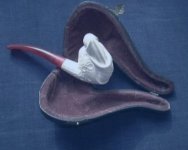One of the prime differences that a young Ozark American learns when he leaves his home and mother dear, and fights the battle of life on his own, is that “outsiders” tend to refuse to use careful philosophical reasoning and long experience to preserve their cherished possessions.
A hillbilly boy buys something that’s good, and he wants to keep it good so his heirs can enjoy it.
I’ll bet the day Harry Hosterman died every one of his briar pipes were clean, well cared for, and are likely still in service.
A new briar pipe, especially a higher grade such as a Lee Star Grade, should be a lifetime possession one’s children can enjoy for ever after.
It should be kept clean, the wood kept shiny with grapeseed oil, and the stem blacked with Obsidian oil. They should never be smoked hot, or wet, and kept rotated. A careful break in once done, need never be repeated.
Those that follow after us, should be given every advantage we can leave them, you know?
You’d not want your kids to say the old man neglected his briars.
Wayfaring Stranger
Traditional
A hillbilly boy buys something that’s good, and he wants to keep it good so his heirs can enjoy it.
I’ll bet the day Harry Hosterman died every one of his briar pipes were clean, well cared for, and are likely still in service.
A new briar pipe, especially a higher grade such as a Lee Star Grade, should be a lifetime possession one’s children can enjoy for ever after.
It should be kept clean, the wood kept shiny with grapeseed oil, and the stem blacked with Obsidian oil. They should never be smoked hot, or wet, and kept rotated. A careful break in once done, need never be repeated.
Those that follow after us, should be given every advantage we can leave them, you know?
You’d not want your kids to say the old man neglected his briars.
Wayfaring Stranger
Traditional








